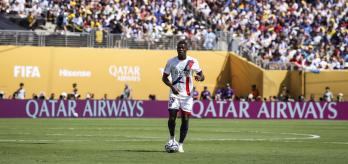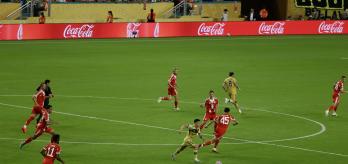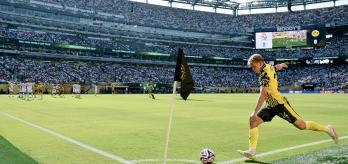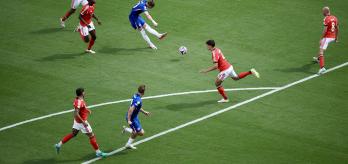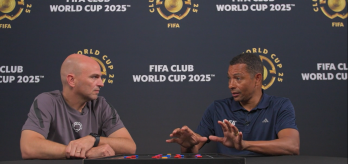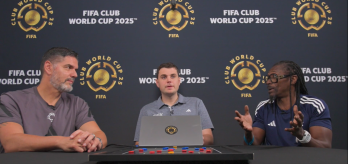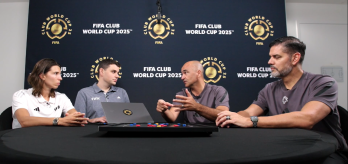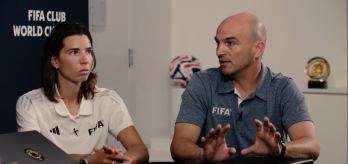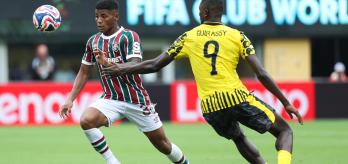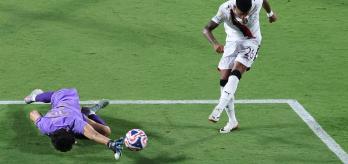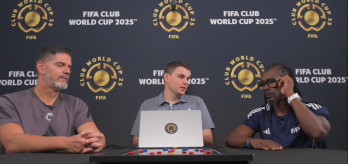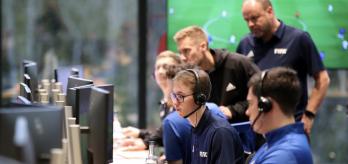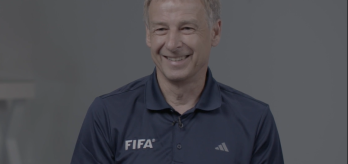In this article, the Portugal national team head coach and member of FIFA’s Technical Study Group (TSG), Roberto Martínez, assesses Fluminense FC’s intense and disciplined defence of this territory against the formidable attacking force of Borussia Dortmund in their FIFA Club World Cup 2025™ opener in the MetLife Stadium in New York.
“Dortmund are very clever in their positional play, using two players as Number 9s, [Karim] Adeyemi (27) and [Serhou] Guirassy (9). They are not traditional number 9 profiles, but they are very disciplined in their positions and how they occupy the space between centre-backs and full-backs, and they played with Julian Brandt (10) very close to them in the number 10 role, before adding a second midfielder, Pascal Groß (13), alongside him.
“The movements they make are designed to penetrate centrally, with one number 9 coming down towards the ball, dragging the centre-back out so that Brandt or Groß can make clever runs into the vacant space behind. In this game, Fluminense used their two centre-backs and two defensive midfielders to man-mark whoever was in that area, and it was really well executed, helping them to keep a clean sheet,” Martínez explained.
Defending the central area with man-to-man responsibilities
The synchronised relationship between Fluminense’s two centre-backs, Thiago Silva (3) and Juan Freytes (22), and their two defensive midfielders, Hércules (35) and Matheus Martinelli (8), was vital in limiting Dortmund’s ability to play the ball through the central channel.
As Martínez explains, “Man-to-man marking needs a lot of communication, but it wasn’t just man-to-man. It was more about defending the area and marking at the right time in the area. So, whoever arrived into the space nearest Hércules or Martinelli, the defensive midfielder made very good decisions about when they had to engage their opponent and were always ready if Dortmund tried to play the ball to either of their two number 10s to prevent them from playing forward to the number 9s.”
In clip 1 below, we see a great example of the collective concentration of Fluminense’s two defensive midfielders and the two centre-backs when following the movement of the ball from a mid-block position. Sometimes, they needed to get closer to the passing lane of the player on the ball and had to advance to prevent a forward pass that could allow Dortmund’s number 9s to access the space behind Fluminense’s defensive line, or to link up with a number 10 in the central area. Martínez highlights their discipline, energy levels, and occasionally having to sprint without the ball to keep the central area protected.
In clip 2, we can see that they mark the area very aggressively and with both responsibility and intensity. As soon as Adeyemi (27) drops into midfield, dragging defensive midfielder Hércules (35) with him, centre-back Silva (3) comes across to cover the space, with Freytes (22) stepping across with him. As soon as the ball is played over the top for Adeyemi, Silva and Freytes track the player and defend the ball. Meanwhile, Hércules covers the space left vacant by Silva and Martinelli fully commits to a strong recovery run, tracking from midfield.
Vital front-foot approach
Borussia Dortmund also wanted their number 9s to drop in deep to receive and for them to play forward to the number 10s, who made attacking runs into the space vacated by the centre-back tracking the number 9. For this system of defending to work, Fluminense’s centre-backs had to commit fully to following their forwards all the way into midfield, being aggressive and getting tight. They could not afford to allow Dortmund’s number 9s to drop short, receive the ball, and create a numerical advantage.
“When centre-backs Silva and Freytes decided they had to defend their forward player, it was important they went all the way to defend the action. They didn’t have to win the ball, but they had to make sure the number 9 could not turn and play forward into the space behind them for the diagonal runs of Brandt and Groß,” Martínez noted.
“The centre-backs gave very good communication if they had to track Adeyemi (27) or Guirassy (9), while the defensive midfielders were never caught by surprise, even when Dortmund tried to use an extra midfielder, with Brandt and Groß both making those attacking runs from deep. What made it successful was that Hércules and Martinelli were always ready to track those runs and defend the space between or behind their centre-backs.”
In clip 3, Martínez highlights the intensity and communication in Fluminense’s defending in the high-press phase. Dortmund are building in a back four (even though they play with a back five). Fluminense centre-back Freytes is allowed to leave his area and go all the way to track a run, knowing that Hércules will cover any runner into the space he leaves behind.
Midfield recovery
Fluminense’s midfielders covered for their centre-backs and tracked third-man runs from Dortmund’s midfield. The work rate and concentration levels from Hércules (35) and Martinelli (8) were vital because Dortmund remained committed to this attacking system for the full game.
Martínez explains, “They were using a lot of energy, sometimes having to sprint without the ball, but always keeping that central area protected, especially if their centre-backs had tracked a forward player into midfield. The communication and trust between the centre-backs and defensive midfielders was vital, as was their discipline when working together for the full 90 minutes.”
In clip 4, we see a great example of a strong recovery run by defensive midfielder Martinelli. Fluminense lose possession from a throw-in, and as his two centre-backs commit to trying to stop the attack, he immediately focuses on recovering into the space where his centre-back should be and is perfectly positioned to make a timely intervention.
Controlled aggression and discipline
Another key factor in Fluminense’s success in this defensive strategy was their ability to defend without conceding free kicks in dangerous central areas, despite the aggressive nature of the defending required. Patience and discipline were necessary in these close-contact duels, according to the Portugal head coach.
“They were careful about how they used their hands or tried to push players away. Their body position and decision-making about when to get tight, when not to, when they should try to win the ball, and when to just stop the player in possession from playing forward were an art of defending, especially when doing all that and not giving away free kicks.”







